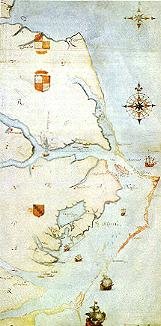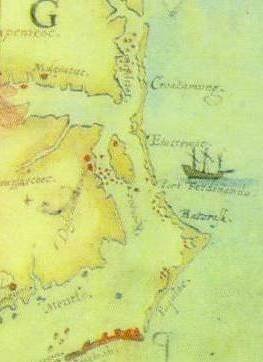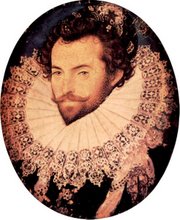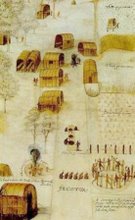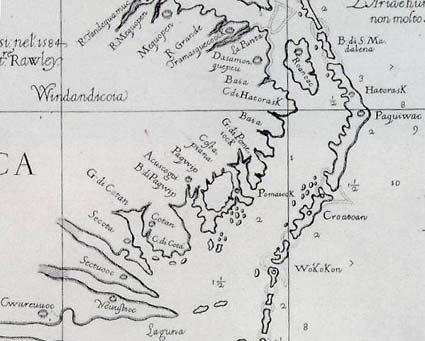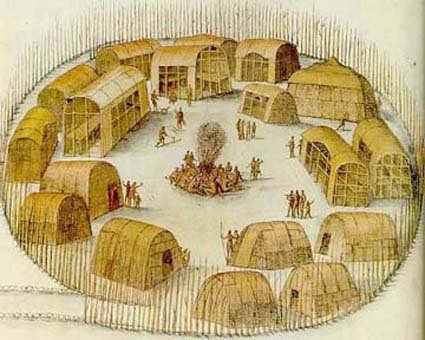by Roberta Estes
For the past several years, the Lost Colony Research Group has sponsored and coordinated an archaeological dig on Hatteras Island. This April marks our fourth dig in cooperation with the University of Bristol and we welcome you to blog along with us on our journey.
Today was arrival day for most of the crew. Several from our group are present at this dig. Not everyone is arriving at the same time. Anne Poole has been here on the island for several days already setting up and getting ready, along with Cousin George. Bless Cousin George, he cooks for us all for 2 weeks on the “gypsy wagon”. Nancy Frey, our British genealogist who lives in Canada arrived yesterday as well.
Louisa, our graduate student from the University of Bristol has also been here for several days preparing as well. She also worked last December on getting ready for this spring’s dig. Coordinating an effort of this size is nothing trivial. Yesterday evening through about 3AM this morning, the rest of the Bristol crew arrived on several flights. Altogether, it was a 25 hour trip for them. Canceled flights and other misadventures plagued them, but eventually they did all arrive safely. This morning was the “things that go bite in the day” lecture. We discovered last year that British students aren’t familiar with the wildlife here that Hatteras Islanders take for granted. You know, things such as snakes, ticks and alligators.
And then, the dig began.
But I hadn’t arrived yet. I was still in the death grip of Old Man Winter – or at least still struggling to escape him. I awoke this morning in Beckley, Va. to discover there was SNOW on the vehicles. Now it was bad enough for me, but folks there believe that spring has already arrived, and there were couple on motorcycles. They had a very cold ride.
I put off my departure by going to Tamarack to see what new and wonderful artisan creations they had, and I was not disappointed. They had ample new goodies to keep me interested for a long time. I’ll probably stop on the way back to purchase. Unfortunately, it is Saturday, and their quilter in residence, Elaine Bliss was not in today. I always enjoy visiting with Elaine.
By 10 AM, I had hoped the snow would have melted off, but it had not. I decided I really needed to go ahead and leave as I had a 9 hour drive in front of me and I really did not want to navigate Highway 12 on Hatteras Island at night. I don’t know….it’s just something about the sea covering the road that I find disconcerting…..
I headed South, after taking note of a very confused goose who was standing in the grassy area of the cloverleaf, wondering to himself where he took a wrong turn, as snow and sleet pelted him. Not only had the snow not melted, it got WORSE and turned into a blizzard. By the time I got to Flat Top, which seemed to be the highest elevation while crossing the Appalachian Mountains, there was a significant amount of snow covering everything. Dawn, who lives on Hatteras Island, pleaded with me to pull over and make a snowball, put it in the cooler and bring it to her. She tells me they don’t get snow on Hatteras. Had I been able to find a place to pull off to take a photo, I would have also gotten her snowball….but that didn’t happen.
By the time I was descending the mountain on the other side of the two tunnels, the snow had stopped and I wondered where the smoke was coming from. Shortly, I discovered it wasn’t smoke, but was fog, drifting through the valleys. Fog was followed by very high winds that caused people to fight for control of their vehicles, then rain, then brilliant sunshine by Winston-Salem and 64 degrees, then overcast by Raleigh and raining off and on between there and Hatteras Island. I have experienced a years worth of weather in just under 12 hours.
I have also discovered that the reason hotels are only open here in the spring, summer and fall is because they do not have heat. Suffice it to say that I’m glad I have long underwear with me and two quilts from my car. If I get any colder, I’ll also be sleeping in my down vest….but I digress.
North Carolina never disappoints me. The beauty and diversity here found in nature and the nature of the people are truly unparalleled elsewhere. One of today’s finds was a house on State road 98 near Rocky Mount that was almost complete covered by wisteria. This reminded me of a forest type of ginger bread house found only fairy tales. Wonderful fodder for a fertile imagination….
Then, in Manteo, I found the most remarkable pink pick-up truck. I didn’t realize that trucks came in this color of pink. I think this must be hibiscus pink. It was parked outside another colorful feature of the island that I’ve talked about during every trip, Kitty Hawk Kites. Truly a colorful scene, and one to be found only on the Outer Banks of North Carolina.
Welcome home!
This blog is © History Chasers
Click here to view all recent Lost Colony Research Group Blog posts 










